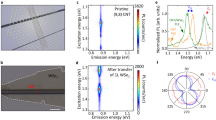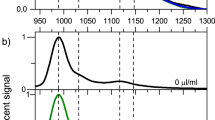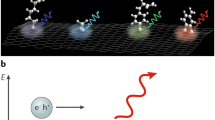Abstract
Despite the attractive one-dimensional characteristics of carbon nanotubes1, their typically low luminescence quantum yield, restricted because of their one-dimensional nature2,3,4,5,6,7,8,9, has limited the performance of nanotube-based light-emitting devices10,11. Here, we report the striking brightening of excitons (bound electron–hole pairs)12,13 in carbon nanotubes through an artificial modification of their effective dimensionality from one dimension to zero dimensions. Exciton dynamics in carbon nanotubes with luminescent, local zero-dimension-like states generated by oxygen doping14 were studied as model systems. We found that the luminescence quantum yield of the excitons confined in the zero-dimension-like states can be more than at least one order larger (∼18%) than that of the intrinsic one-dimensional excitons (typically ∼1%), not only because of the reduced non-radiative decay pathways but also due to an enhanced radiative recombination probability beyond that of intrinsic one-dimensional excitons. Our findings are extendable to the realization of future nanoscale photonic devices including a near-infrared single-photon emitter operable at room temperature.
This is a preview of subscription content, access via your institution
Access options
Subscribe to this journal
Receive 12 print issues and online access
$209.00 per year
only $17.42 per issue
Buy this article
- Purchase on Springer Link
- Instant access to full article PDF
Prices may be subject to local taxes which are calculated during checkout




Similar content being viewed by others
References
Saito, R., Dresselhaus, G. & Dresselhaus, M. S. Physical Properties of Carbon Nanotubes (Imperial College Press, 1998).
Perebeinos, V., Tersoff, J. & Avouris, P. Radiative lifetime of excitons in carbon nanotubes. Nano Lett. 5, 2495–2499 (2005).
Spataru, C. D., Ismail-Beigi, S., Capaz, R. B. & Louie, S. G. Theory and ab initio calculation of radiative lifetime of excitons in semiconducting carbon nanotubes. Phys. Rev. Lett. 95, 247402 (2005).
Cognet, L. et al. Stepwise quenching of exciton fluorescence in carbon nanotubes by single-molecule reactions. Science 316, 1465–1468 (2007).
Rajan, A., Strano, M. S., Heller, D. A., Hertel, T. & Schulten, K. Length-dependent optical effects in single walled carbon nanotubes. J. Phys. Chem. B 112, 6211–6213 (2008).
Miyauchi, Y., Matsuda, K., Yamamoto, Y., Nakashima, N. & Kanemitsu, Y. Length-dependent photoluminescence lifetimes in single-walled carbon nanotubes. J. Phys. Chem. C 114, 12905–12908 (2010).
Miyauchi, Y., Hirori, H., Matsuda, K. & Kanemitsu, Y. Radiative lifetimes and coherence lengths of one-dimensional excitons in single-walled carbon nanotubes. Phys. Rev. B 80, 081410(R) (2009).
Hertel, T., Himmelein, S., Ackermann, T., Stich, D. & Crochet, J. Diffusion limited photoluminescence quantum yields in 1-D semiconductors: single-wall carbon nanotubes. ACS Nano 4, 7161–7168 (2010).
Harrah, D. M. & Swan, A. K. The role of length and defects on optical quantum efficiency and exciton decay dynamics in single-walled carbon nanotubes. ACS Nano 5, 647–655 (2011).
Mueller, T. et al. Efficient narrow-band light emission from a single carbon nanotube p–n diode. Nature Nanotech. 5, 27–31 (2010).
Hertel, T. Carbon nanotubes: a brighter future. Nature Photon. 4, 77–78 (2010).
Ando, T. Excitons in carbon nanotubes. J. Phys. Soc. Jpn 66, 1066–1073 (1997).
Wang, F., Dukovic, G., Brus, L. E. & Heinz, T. F. The optical resonances in carbon nanotubes arise from excitons. Science 308, 838–841 (2005).
Ghosh, S., Bachilo, S. M., Simonette, R. A., Beckingham, K. M. & Weisman, R. B. Oxygen doping modifies near-infrared band gaps in fluorescent single-walled carbon nanotubes. Science 330, 1656–1659 (2010).
O'Connell, M. J. et al. Band gap fluorescence from individual single-walled carbon nanotubes. Science 297, 593–596 (2002).
Lebedkin, S. et al. FTIR-luminescence mapping of dispersed single-walled carbon nanotubes. New J. Phys. 5, 140 (2003).
Crochet, J., Clemens, M. & Hertel, T. Quantum yield heterogeneities of aqueous single-wall carbon nanotube suspensions. J. Am. Chem. Soc. 129, 8058–8059 (2007).
Ju, S.-Y., Kopcha, W. P. & Papadimitrakopoulos, F. Brightly fluorescent single-walled carbon nanotubes via an oxygen-excluding surfactant organization. Science 323, 1319–1323 (2009).
Lee, A. J. et al. Bright fluorescence from individual single-walled carbon nanotubes. Nano Lett. 11, 1636–1640 (2011).
Crochet, J. J., Duque, J. G., Werner, J. H. & Doorn, S. K. Photoluminescence imaging of electronic-impurity-induced exciton quenching in single-walled carbon nanotubes. Nature Nanotech. 7, 126–132 (2012).
Högele, A., Galland, C., Winger, M. & Imamoğlu, A. Photon antibunching in the photoluminescence spectra of a single carbon nanotube. Phys. Rev. Lett. 100, 217401 (2008).
Hirori, H., Matsuda, K., Miyauchi, Y., Maruyama, S. & Kanemitsu, Y. Exciton localization of single-walled carbon nanotubes revealed by femtosecond excitation correlation spectroscopy. Phys. Rev. Lett. 97, 257401 (2006).
Kilina, S., Ramirez, J. & Tretiak, S. Brightening of the lowest exciton in carbon nanotubes via chemical functionalization. Nano Lett. 12, 2306–2312 (2012).
Nagatsu, K., Chiashi, S., Konabe, S. & Homma, Y. Brightening of triplet dark excitons by atomic hydrogen adsorption in single-walled carbon nanotubes observed by photoluminescence spectroscopy. Phys. Rev. Lett. 105, 157403 (2010).
Iakoubovskii, K. et al. Midgap luminescence centers in single-wall carbon nanotubes created by ultraviolet illumination. Appl. Phys. Lett. 89, 173108 (2006).
Lefebvre, J., Austing, D. G., Bond, J. & Finnie, P. Photoluminescence imaging of suspended single-walled carbon nanotubes. Nano Lett. 6, 1603–1608 (2006).
Tomio, Y. & Suzuura, H. Aharonov–Bohm effect on impurity-bound excitons in semiconducting carbon nanotubes. J. Phys. Conf. Ser. 302, 012005 (2011).
Takagahara, T. & Hanamura, E. Giant-oscillator-strength effect on excitonic optical nonlinearities due to localization. Phys. Rev. Lett. 56, 2533–2536 (1986).
Lüer, L. et al. Size and mobility of excitons in (6, 5) carbon nanotubes. Nature Phys. 5, 54–58 (2009).
Mizuochi, N. et al. Electrically driven single-photon source at room temperature in diamond. Nature Photon. 6, 299–303 (2012).
Acknowledgements
This research was supported by Precursory Research for Embryonic Science and Technology (PRESTO) programme (no. 3538 from the Japan Science and Technology Agency (JST)), by Grants-in-Aid for Scientific Research (nos 24681031, 22740195 and 23340085 from the Japan Society for the Promotion of Science (JSPS); no. 22016007 from the Ministry of Education, Culture, Sports, Science and Technology, Japan (MEXT)), and by Asahi Glass Foundation. The authors thank Y. Kawazoe, M. Uesugi, N. Tokitoh, T. Murakami, T. Umeyama and H. Imahori for experimental equipment and T. F. Heinz for discussions.
Author information
Authors and Affiliations
Contributions
Y.M. developed the concept, designed the experiment and prepared the manuscript. Y.M. and M.I. performed the optical measurements. T.K. and M.O. contributed to the time-resolved photoluminescence measurements. M.I. prepared the samples. Y.M., M.I., S.M. and K.M. contributed to interpreting the results and writing the manuscript. All authors discussed the results and commented on the manuscript.
Corresponding author
Ethics declarations
Competing interests
The authors declare no competing financial interests.
Supplementary information
Supplementary information
Supplementary information (PDF 2328 kb)
Rights and permissions
About this article
Cite this article
Miyauchi, Y., Iwamura, M., Mouri, S. et al. Brightening of excitons in carbon nanotubes on dimensionality modification. Nature Photon 7, 715–719 (2013). https://doi.org/10.1038/nphoton.2013.179
Received:
Accepted:
Published:
Issue Date:
DOI: https://doi.org/10.1038/nphoton.2013.179
This article is cited by
-
Selective emergence of photoluminescence at telecommunication wavelengths from cyclic perfluoroalkylated carbon nanotubes
Communications Chemistry (2023)
-
Recent advances in room temperature single-photon emitters
Quantum Information Processing (2023)
-
Formation of organic color centers in air-suspended carbon nanotubes using vapor-phase reaction
Nature Communications (2022)
-
Quantum defects as versatile anchors for carbon nanotube functionalization
Nature Protocols (2022)
-
Synthetic control over the binding configuration of luminescent sp3-defects in single-walled carbon nanotubes
Nature Communications (2021)



